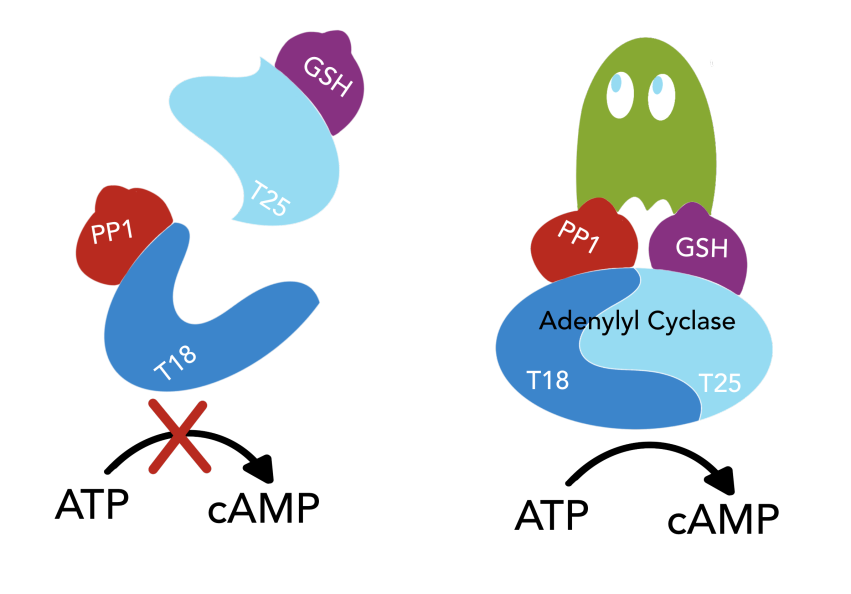Part:BBa_K3802003
GSH/T25 Fusion Protein
Contents
Sequence and Features
This fusion protein consists of the antioxidant glutathione (GSH) (BBa_K2571001) attached to the T25 subdomain of adenylyl cyclase (BBa_K1638002) with a 54 amino acid Gly-Gly-Ser Linker (BBa_K3128010). The sequence was set under the control of a constitutive promoter (BBa_J23112), has ribosome binding site (Part:BBa_J61102 ), and terminator (BBa_K3128010). This biobrick is one part of a bacterial two-hybrid assay that serves as a novel detection system for microcystin-LR ( MC-LR). It is used in conjunction with a fusion protein combining protein phosphatase 1(PP1) and the T18 subdomain of adenylyl cyclase (BBa_K3802002).
- 10COMPATIBLE WITH RFC[10]
- 12INCOMPATIBLE WITH RFC[12]Illegal NheI site found at 7
Illegal NheI site found at 30 - 21INCOMPATIBLE WITH RFC[21]Illegal BglII site found at 1157
Illegal BamHI site found at 1369 - 23COMPATIBLE WITH RFC[23]
- 25INCOMPATIBLE WITH RFC[25]Illegal NgoMIV site found at 209
Illegal NgoMIV site found at 1508 - 1000COMPATIBLE WITH RFC[1000]
Usage and Biology
Bacterial Two-Hybrid Assay
Two-Hybrid Assays function to observe how interactions between two proteins can stimulate or alter signalling cascades. The particular cascade observed in this assay has the main goal of altering the level of cyclic AMP (cAMP), an important second messenger that binds to catabolite activator protein (CAP). When cAMP and CAP come together, they create a complex able to bind to promoters and regulate the transcription of desired reporter genes. [1]. Adenylyl cyclase is the enzyme that synthesizes cAMP, and within the bacteria Bordella pertussis , it was found that its catalytic domain could be split into two subdomains: T18 and T25 [2]. Individually, these domains were nonfunctional, but when brought together, they are able to reconstitute adenylyl cyclase that can function as intended. To facilitate this reconstitution, each subdomain can be fused with a protein of interest, and the interactions of these proteins of interest bring both subdomains together, ultimately restoring adenylyl cyclase for cAMP production.
Microcystin Detection
This novel detection system is based on MC-LR’s natural ability to inhibit human PP1, a contributing factor to its hepatotoxicity. Commonly used protein phosphatase assays use spectrophotometry to measure the yellow colored product generated by PP1 converting its substrate, p-nitrophenyl phosphate (pNPP) to p-nitrophenol (pNP). By monitoring absorbance at 405 nm in the presence of pNPP and PP1, the reaction rate, and indirectly the concentration of MC-LR, can be measured. High MC-LR concentration leads to greater PP1 inhibition and a less yellow solution (low absorbance)[2]. On the other hand, a low MC-LR concentration would be associated with less PP1 inhibition, faster conversion of pNPP to pNP and higher absorbance. If MlrA is correctly localized to the outer membrane, this would lead to lower MC-LR concentration, less PP1 inhibition and, in turn, increased absorbance [3].
In the bacterial two-hybrid assay, PP1 acts as one of the proteins of interest, bound to adenylyl cyclase subdomain T18. When MC-LR is present, its Adda site binds to PP1 and the Mdha site creates a covalent bond with this enzyme, causing irreversible inhibition. The second protein GSH is bound to the T25 subdomain. GSH can occupy the Mdha site of MC-LR to reduce its overall toxicity when it attempts to inhibit PP1[4]. When both GSH and PP1 bind to MC-LR, the T18 and T25 subunits can come close enough together to reconstitute adenylyl cyclase, increase cAMP production, and activate transcription of desired reporter proteins.

In the above figure, MC-LR causes PP1 and GSH to interact, subsequently bringing together T18 and T25 subunits of adenylyl cyclase.
References
[1]: Battesti, A., & Bouveret, E. (2012). The bacterial two-hybrid system based on adenylate cyclase reconstitution in Escherichia coli. Methods, 58(4), 325–334. https://doi.org/10.1016/j.ymeth.2012.07.018
[2]: Moore, C., Juan, J., Lin, Y., Gaskill, C., & Puschner, B. (2016). Comparison of Protein Phosphatase Inhibition Assay with LC-MS/MS for Diagnosis of Microcystin Toxicosis in Veterinary Cases. Marine Drugs, 14(3), 54. https://doi.org/10.3390/md14030054
[3]: Akin-Oriola, G., & Lawton, L. (2010). Detection and quantification of toxins in cultures of microcystis aeruginosa (pcc 7820) by hplc and protein phosphatase inhibition assay effect of blending various collectors at bulk. African Journal of Science and Technology, 6(1). https://doi.org/10.4314/ajst.v6i1.55157
[4]: Zong, W., Wang, X., Du, Y., Zhang, S., Zhang, Y., & Teng, Y. (2017). Molecular Mechanism for the Regulation of Microcystin Toxicity to Protein Phosphatase 1 by Glutathione Conjugation Pathway. BioMed research international, 2017, 9676504. https://doi.org/10.1155/2017/9676504
| None |
